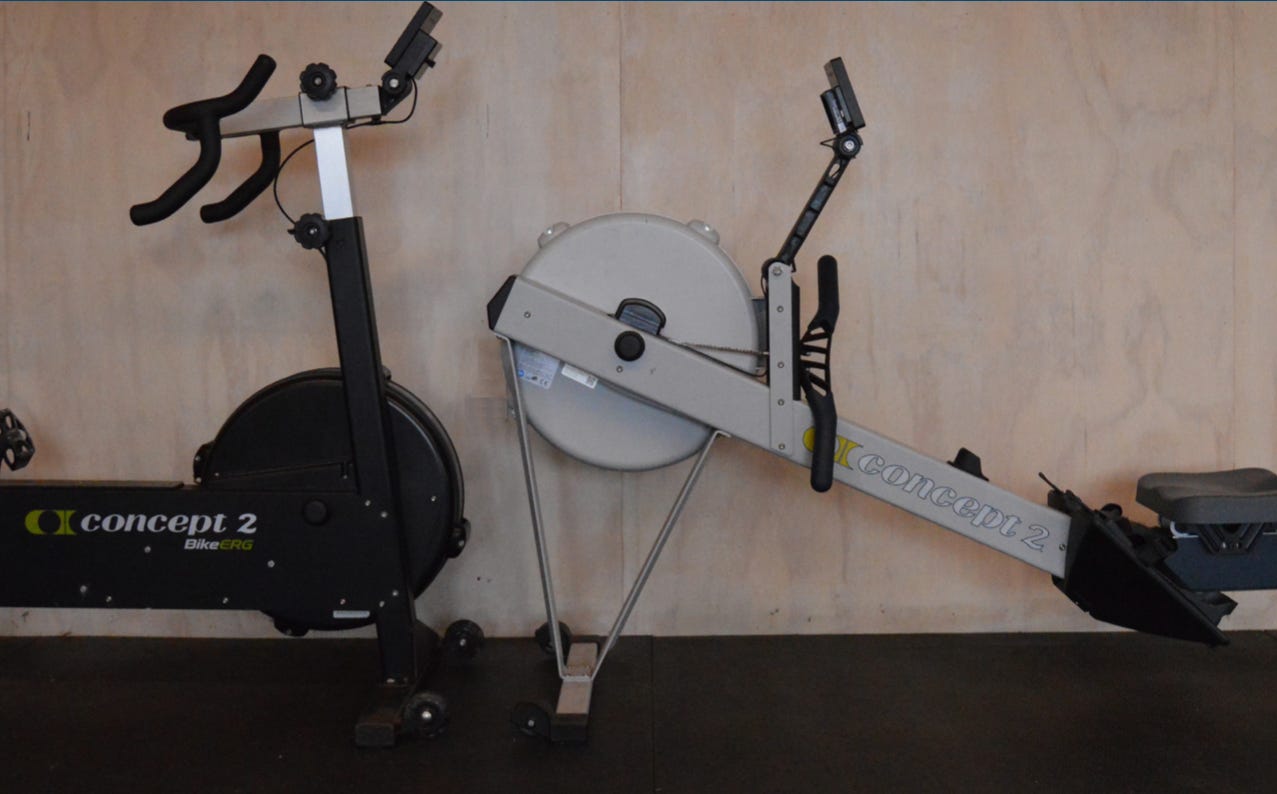I was tagged into a discussion last month about differences in blood lactate levels under maximal testing when cycling, running, and erging, and how and why different modes of training would produce different results.
Why would we expect them to be the same in the first place?
Cycling, running, erging, and rowing all involve different movement patterns, different resistance forces (gravity, water, air, etc.), and different body parts working in different ways. Many rowers also do cross-country skiing or use the SkiErg, adding yet more variables. Why would the physiological capacity compare equally across such different modes of locomotion?
There are two recent studies on cycling and erging informing this perspective.
In 2018, researchers studied 20 male rowers from Australia’s 2017 World Championship Team using a 7x4’ submax step test protocol on a WattBike versus a Concept2 Model D rowing erg. They found that VO2 and heart-rate were increased on the erg versus the bike, but that blood lactate and rate of perceived exertion were equivalent between the two at equal power outputs.
Researchers in a 2020 study evaluated 10 male rowers with a 6:36 2k erg average using a 4x6’ submax step test protocol. They found that equivalent power outputs on the Concept2 BikeErg and RowErg resulted in greater physiological impact on the RowErg. VO2, heart-rate, blood lactate, and rate of perceived exertion were all higher on the RowErg despite equivalent wattage on the same brand of machine (with a standardized performance monitor).
The 2018 authors set out to answer the question of how to prescribe training load for rowers substituting cycling sessions for erging. They concluded that their findings reveal more questions than answers due to the apparent decoupling of physiological parameters that they expected to track together. The 2020 study avoided the issue of prescribing training, but does find the more expected result of similarly greater physiological impact across all parameters when erging versus cycling.
Of course, both of these studies are on a male elite population, so we need replication with juniors, women, masters, and para rowers to understand group and individual differences.
Rowers seem to feel or understand that holding one level of physiological output on the bike is easier than holding that same level on the erg. This could be due to the greater amount of muscle mass required when erging versus biking. Early sports science research indicates that VO2 max can be up to 10% higher when the athlete is using both legs and arms, as opposed to legs only. This can be true even when the arms are just stabilizing the athlete on the bike, not even directly contributing to movement.
Concept2, manufacturers of the BikeErg, SkiErg, and RowErg, doesn’t claim to have an answer here either. The closest I was able to find was an explanation that the pace display on the performance monitor is set to be equal between BikeErg and RowErg: “The wattage required to go at a given pace per 500m on the indoor rower is the same wattage required to go at that pace per 1000m on the BikeErg. However, the “meters” traveled has been given a value that more closely simulates biking on the road, and has been pegged at 2X for the same power. For the coach planning a 5k piece who also has athletes on the BikeErg, a 10k BikeErg piece would be an equivalent workout.”
It’s possible that this is one way that “double your rowing volume to make a biking session” became standard training guidance. This would be true in meters (because of the technological difference in C2 performance monitor display), but not necessarily in minutes (or when using non-C2 technology). Other coaches and rowers propose biking 1.5x the rowing volume. We seem to understand that biking is physiologically easier than rowing at equal paces, but I think there are too many interfering factors and not enough consistency in training, pacing, and protocols to be able to issue a firm rule of comparison.
A few actionable strategies emerge from this discussion:
Use one physiological metric (eg. VO2, HR, BLa, etc.) rather than pace and hold time equal, because this trains the cardiovascular systems close enough to equally.
Use power output (ie. watts or split) to guide training, and do a little more cycling than erging, because research generally indicates greater physiological impact from erging.
Keep the training equal between modes and adjust based on RPE, because research indicates that power and physiological outputs are different but that perceived exertion can be a good guide across modes.
Cross-train without worrying about how it compares to the performance condition, because research isn’t clear enough on how they compare, and you can use your erging or rowing results to determine if the cross-training is working.
Just exercise, because it’s good.





